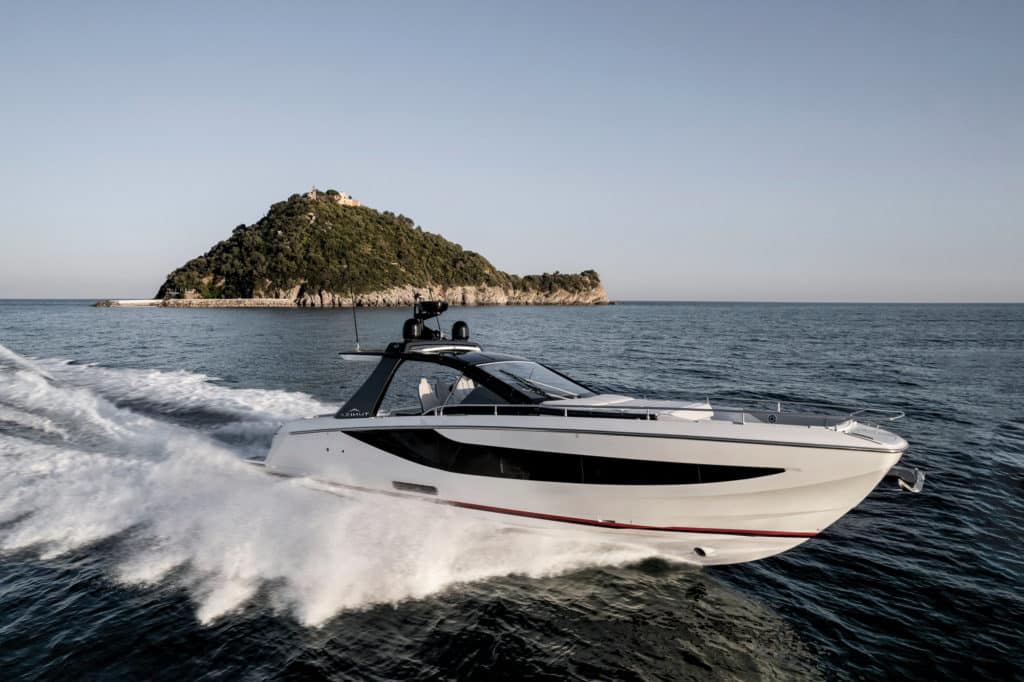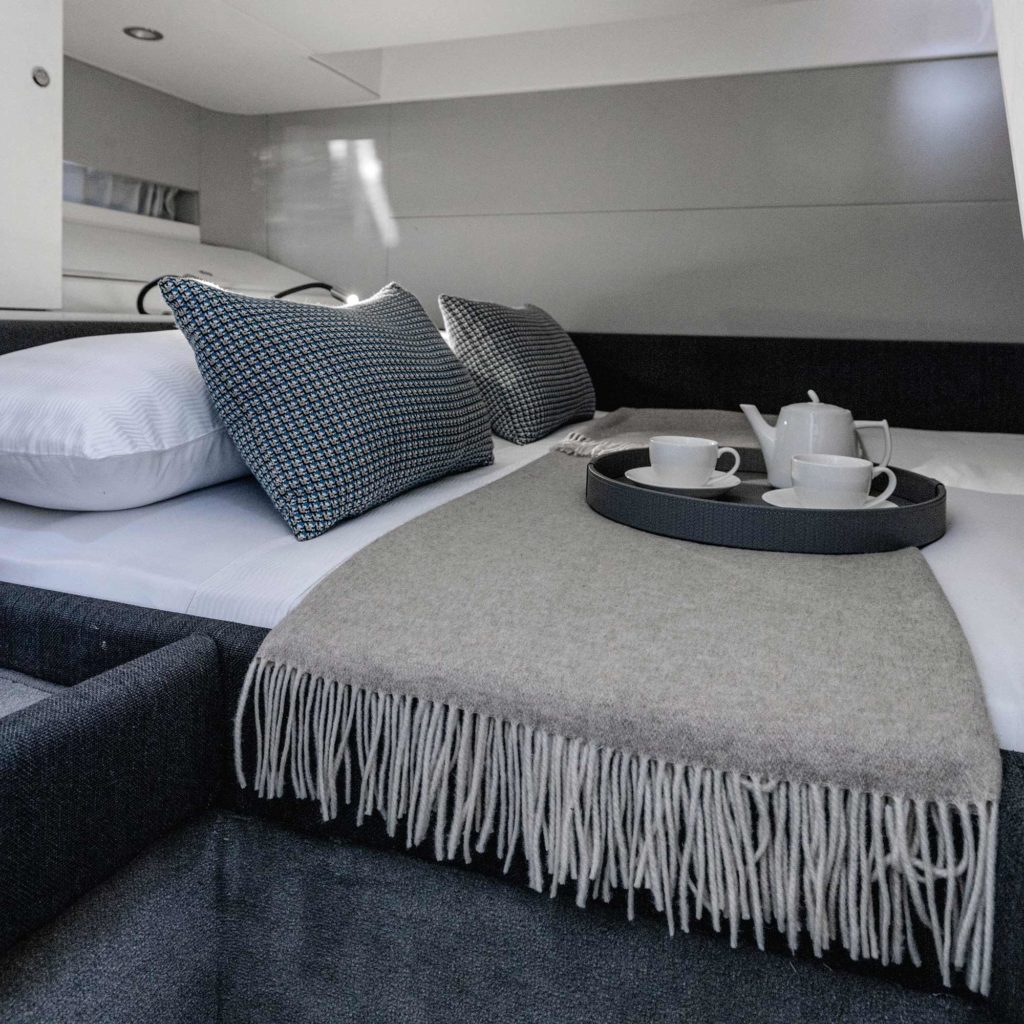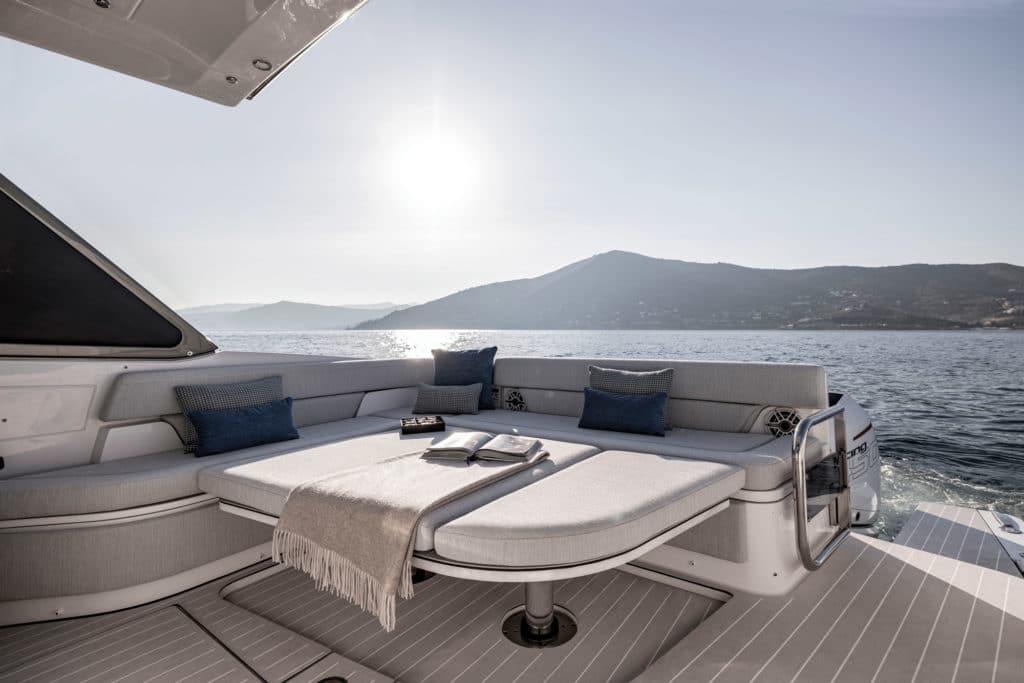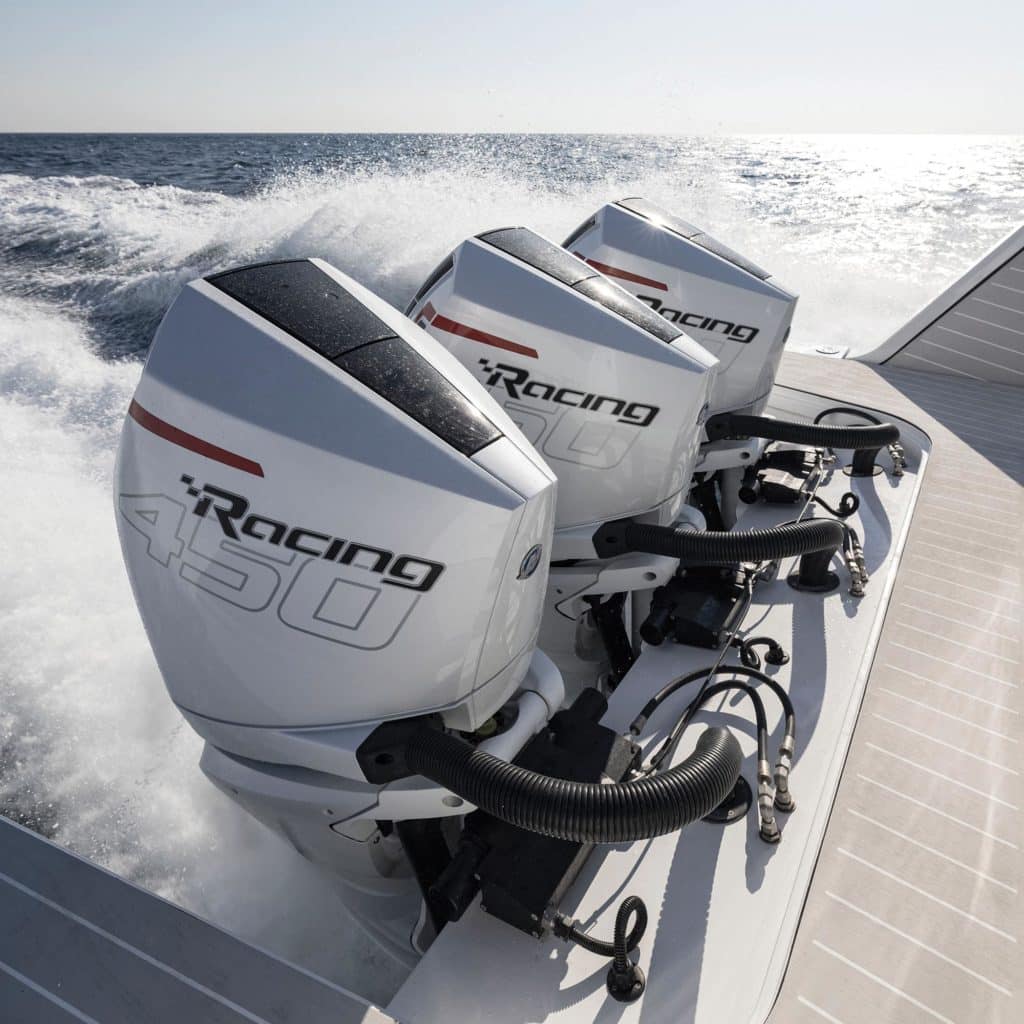
Sea trials are often relatively calm affairs: Run the boat on reasonably smooth water, grab the performance numbers and get a sense of the boat. My run on the Azimut Yachts Verve 42 was a bit more lively.
First, as we headed out the Port Everglades inlet in Fort Lauderdale, Florida, I could see mountains moving in the Gulf Stream just offshore. Second, the skipper was Federico Ferrante, president of Azimut Benetti USA and clearly an aspiring Formula One driver. Before we cleared the inlet, he grabbed a fistful of throttles for the triple 450 hp Mercury Racing outboards, and we were off on Mr. Toad’s Wild Ride. I’ve run the Miami-Nassau powerboat race from Florida to the Bahamas and taken less abuse than we tried to give the Verve that afternoon.
And the 42-footer took it in stride. Blasting off waves, the boat landed softly thanks to the 22.5-degree transom deadrise and Michael Peters hull form. Yes, there was spray, but most of it was thrown aside, courtesy of double strakes and a wide spray chine/rail. We were in flat water long enough to see a top speed of 45 knots, and then the Gulf Stream dictated our speeds while we occasionally pushed the envelope.

This is a yacht that can make it from Florida to Bimini in just over an hour (given less-strenuous conditions) and that has comfortable overnight accommodations upon arrival. There is a queen-size berth in a private stateroom, a head with a shower (that itself has 6-foot-6-inch headroom) and a convertible V-berth for kids or friends.
Getting aboard, whether from the water or a dock, is easy. First, there is a full-beam transom walkway a step down from the cockpit and forward of the engines. A portside deck unfolds to create a beach, and there is a stainless-steel ladder with wide rungs for swimmers.
Then, it’s relaxation time. In the cockpit, the L-shaped settee wraps around the starboard side, with a table that rises electrically from the sole when needed. Just forward and tucked abaft the helm seats are an Isotherm fridge and ice maker.

The deck layout might be termed “semi-center-console,” since the starboard side has a conventional raised deck (steps up from the cockpit), while the port side is a dedicated walkway at cockpit level around the house to make access to the bow seating easy and safe.
At the foredeck, there is a sun pad with backrests for two to three people atop the cabin house. A U-shaped settee in the bow around a table calls out for sundowners and munchies at anchor under the awning. The 42’s hidden anchor windlass has a remote control and a locker to hold 130 feet of chain. For security, the entire bow is surrounded by welded stainless-steel rails.
In the pilothouse are three electrically adjustable bolstered seats (think Ferrari-type side bolsters) and a raised foot brace. The vessel’s black dash has subtle blue lighting and space for twin 15-inch Raymarine multifunction displays abaft the windshield, which has a single pantograph wiper. To keep things cool, there are air-conditioning vents in the dash and an overhead hatch next to rows of aircraft-style push-button switches. The skipper has access to the Humphree automatic trim system to keep the 42 running flat and fast in all conditions.

Below is a cool, serene Italian condo designed by Francesco Struglia, all grays and blacks and nubby upholstery. To port is the galley, mostly hidden behind lacquered cabinetry, with a Kenyon induction range, Miele oven, fridge and sink.
Opposite is the head compartment with an electric toilet and sink, as well as a separate glass-door stall shower with a seat. Forward, seating wraps around a table that lowers electrically to form a couple-size V-berth, and a TV is mounted on the after bulkhead.
The owner’s stateroom is aft with a privacy door. Windows, including an opening portlight, are hidden in the exterior swoosh graphics. They make the area bright. Stowage is hidden in the headboard.
Electrical power is provided by an 11 kW Onan generator that’s tucked under the cockpit, with access through a deck hatch. This unit easily handles the triple-zone air conditioning and galley needs.
The Verve 42 also has a sizable undercockpit room, thanks to the powerplants hanging off the stern. Owner-operators will find a step-in service area for the outboard systems, as well as an aft “hold” in the transom that’s large enough to serve as a garage for water toys, fenders and lines.
The Azimut Verve 42 is well-mannered, even with the 1,350 horses, and is a stylish day cruiser with weekending capability. It never hurts that owners can put down the hammer to get to any destination in a hurry. As an alternative to center-consoles with limited liveaboard space or conventional express cruisers without forward seating, the Verve 42 offers the best of all worlds.
It’s a Hull Thing
Michael Peters designed the Verve 42’s hull using his patented Stepped-Vee Ventilated Tunnel hull. This deep-V design incorporates twin athwartships steps and a stern tunnel. The result is as soft riding as a conventional deep-V hull but with improved directional stability and solid tracking when turning at speed.
Driving Force
The Mercury Racing 450R outboard is purpose-built for high performance, with a V-8, 4.6-liter quad-cam powerhead. A Mercury Racing belt-driven supercharger ups the horsepower to 450. Engine mounts isolate vibration, and electrohydraulic steering is standard. Routine oil checks and top-offs can be done via the Mercury pop-off service door.
How It’s Made
The Verve 42’s hull is built from conventional fiberglass using vinylester resins for blister protection, while the deck and hardtop include carbon fiber for strength without added weight. The Verve 42 is built to CE Classification Type A, making it suitable for sea voyages where winds can exceed 45 mph and seas can grow to 13 feet.
Take the next step: azimutyachts.com








